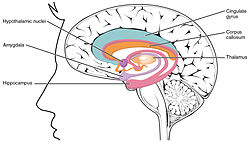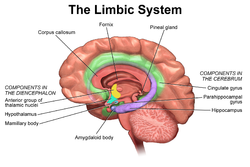Hippocampus
- For the small fish, go to seahorse
The hippocampus is part of the mammalian brain, and belongs to the limbic system. Humans and other mammals have two, one in each side of the brain. The hippocampus is under the cerebral cortex.[1] It is important in spatial memory and navigation, and helps turn short-term memory into long-term memory. The hippocampus is named after the seahorse because its shape is similar.
| Brain: Hippocampus | ||
|---|---|---|
| The hippocampus is located in the medial temporal lobe of the brain. In this lateral view of the human brain, the frontal lobe is at the left, the occipital lobe at the right, and the temporal and parietal lobes have largely been removed to reveal the hippocampus underneath. | ||
| Hippocampus (lowest pink bulb) as part of the limbic system | ||
| Latin | Hippocampus | |
| Part of | Temporal lobe | |
In Alzheimer's disease, the hippocampus is one of the first regions of the brain to suffer damage; memory loss and disorientation are included among the early symptoms. People with extensive, bilateral hippocampal damage may experience anterograde amnesia – the inability to form or retain new memories.
The different neuronal cell types are neatly organized into layers in the hippocampus. It has often been used as a model system for studying neurophysiology. Long-term potentiation (LTP), a neural mechanism for storing memory, was first discovered to occur in the hippocampus.
Hippocampus and memory
The connection of hippocampus with memory was made by a famous report.[2] This gave the results of the destruction of the hippocampi by surgery (an attempt to relieve epileptic seizures).[3] The unexpected outcome of the surgery was severe anterograde and partial retrograde amnesia. The patient could not form new memories of events after his surgery, and could not remember any events that occurred just before his surgery. However, he did remember events from many years earlier, right back to his childhood.
This case attracted widespread professional interest.[4] Later, other patients with similar damage and amnesia (caused by accident or disease) have also been studied. Thousands of experiments have studied the physiology of changes in synaptic connections in the hippocampus after activity. The hippocampi do play an important role in memory. However, the precise nature of this role remains unclear.[5][6]
Recent reviews say how the hippocampus puts together our memories of past events, and helps us remember aspects of complex events.[7][8]
Hippocampus and orientation
Neurons in the rat hippocampus show activity related to the rat's position in its environment.[9][10] As with the memory theory, there is now almost universal agreement that spatial coding plays an important role in hippocampal function, but the details are widely debated.[11]
Studies conducted on freely moving rats and mice have shown that many hippocampal neurons have "place fields", that is, they fire bursts of action potentials when a rat passes through a particular part of the environment. In humans, cells with location-specific firing patterns have been reported in a study. Patients with drug-resistant epilepsy had diagnostic electrodes put in their hippocampus. Then a computer was used to move them around in a virtual reality town.[12]
The discovery of place cells in the 1970s led to a theory that the hippocampus might act as a cognitive map –a neural representation of the layout of the environment.[10] The "cognitive map hypothesis" has been further advanced by recent discoveries of direction cells in several parts of the rodent brain which are strongly connected to the hippocampus.[11][13]
Evolution
The hippocampus has a generally similar appearance across the mammals from monotremes such as the echidna to primates such as humans.[14] The hippocampal size to body-size ratio increases: it is about twice as large for primates as for the echidna. It does not, however, increase at anywhere close to the rate of the neocortex to body-size ratio. Therefore, the hippocampus takes up a larger fraction of the cortex in rodents than in primates.
Other vertebrates have areas which may be homologous to the hippocampus of mammals.[15] Some insects, and cephalopods such as the octopus, have strong spatial learning and navigation abilities. These appear to work differently from the mammalian spatial system, and have evolved independently of the mammalian system.
Hippocampus Media
Hippocampus in the limbic system
Cross-section of cerebral hemisphere showing structure and location of hippocampus
Basic circuit of the hippocampus, as drawn by Ramón y Cajal. DG: dentate gyrus. Sub: subiculum. EC: entorhinal cortex
Hippocampal subregions, and subfields
Rats and cognitive maps
Spatial firing patterns of eight place cells recorded from the CA1 layer of a rat. The rat ran back and forth along an elevated track, stopping at each end to eat a small food reward. Dots indicate positions where action potentials were recorded, with color indicating which neuron emitted that action potential.
References
- ↑ "Limbic System: Hippocampus (Section 4, Chapter 5) Neuroscience Online: An Electronic Textbook for the Neurosciences | Department of Neurobiology and Anatomy - the University of Texas Medical School at Houston". Archived from the original on 2015-11-14. Retrieved 2014-02-28.
- ↑ Scoville W.B. & Milner B. 1957. Loss of recent memory after bilateral hippocampal lesions. J. Neurol. Neurosurg. Psych. 20 (1): 11–21. [1]
- ↑ N.Y. Times, 12-06-2008
- ↑ Squire L.R. 2009. The legacy of patient H.M. for neuroscience. Neuron 61 (1): 6–9. [2]
- ↑ Squire L.R. 1992. Memory and the hippocampus: a synthesis from findings with rats, monkeys, and humans. Psych. Rev. 99 (2): 195–231. [3]
- ↑ Eichenbaum H. & Cohen N.J. 1993. Memory, amnesia, and the hippocampal system. MIT Press.
- ↑ Webb, Jonathan 2015. Peeking into the brain's filing system. BBC News Science & Environment. [4]
- ↑ Horner, Adrian J et al 2015. Evidence for holistic episodic recollection via hippocampal pattern completion. Nature Communications 6, article number 7462. [5]
- ↑ O'Keefe J. & Dostrovsky J. 1971. The hippocampus as a spatial map. Preliminary evidence from unit activity in the freely-moving rat. Brain Res 34 (1): 171–75. [6]
- ↑ 10.0 10.1 O'Keefe J. & Nadel L. 1978. The hippocampus as a cognitive map. Oxford University Press.
- ↑ 11.0 11.1 Moser E.I; Kropf E. & Moser M-B. 2008. Place cells, grid cells, and the brain's spatial representation system. Ann. Rev. Neurosci. 31: 69 [7] Archived 2015-06-30 at the Wayback Machine
- ↑ Ekstrom A.D. et al 2003. Cellular networks underlying human spatial navigation. Nature 425 (6954): 184–88. [8]
- ↑ Solstad T. et al 2008. Representation of geometric borders in the entorhinal cortex. Science 322 (5909): 1865–68. [9]
- ↑ West M.J. 1990. Stereological studies of the hippocampus: a comparison of the hippocampal subdivisions of diverse species including hedgehogs, laboratory rodents, wild mice and men. Prog. Brain Res. 83: 13–36. [10]
- ↑ Rodríguez F. et al 2002. Spatial memory and hippocampal pallium through vertebrate evolution: insights from reptiles and teleost fish. Brain Res. Bull. 57 (3–4): 499–503. [11]











